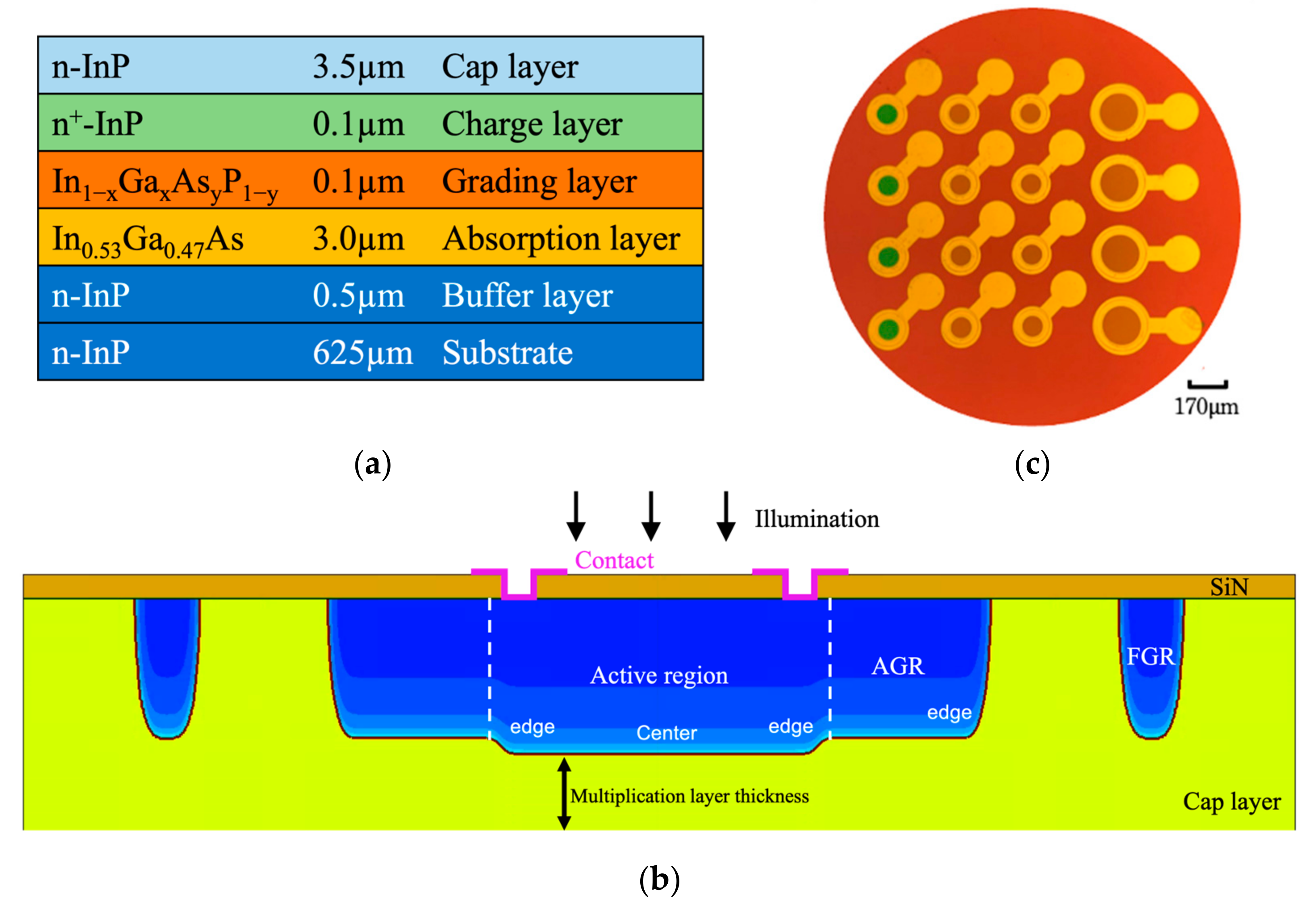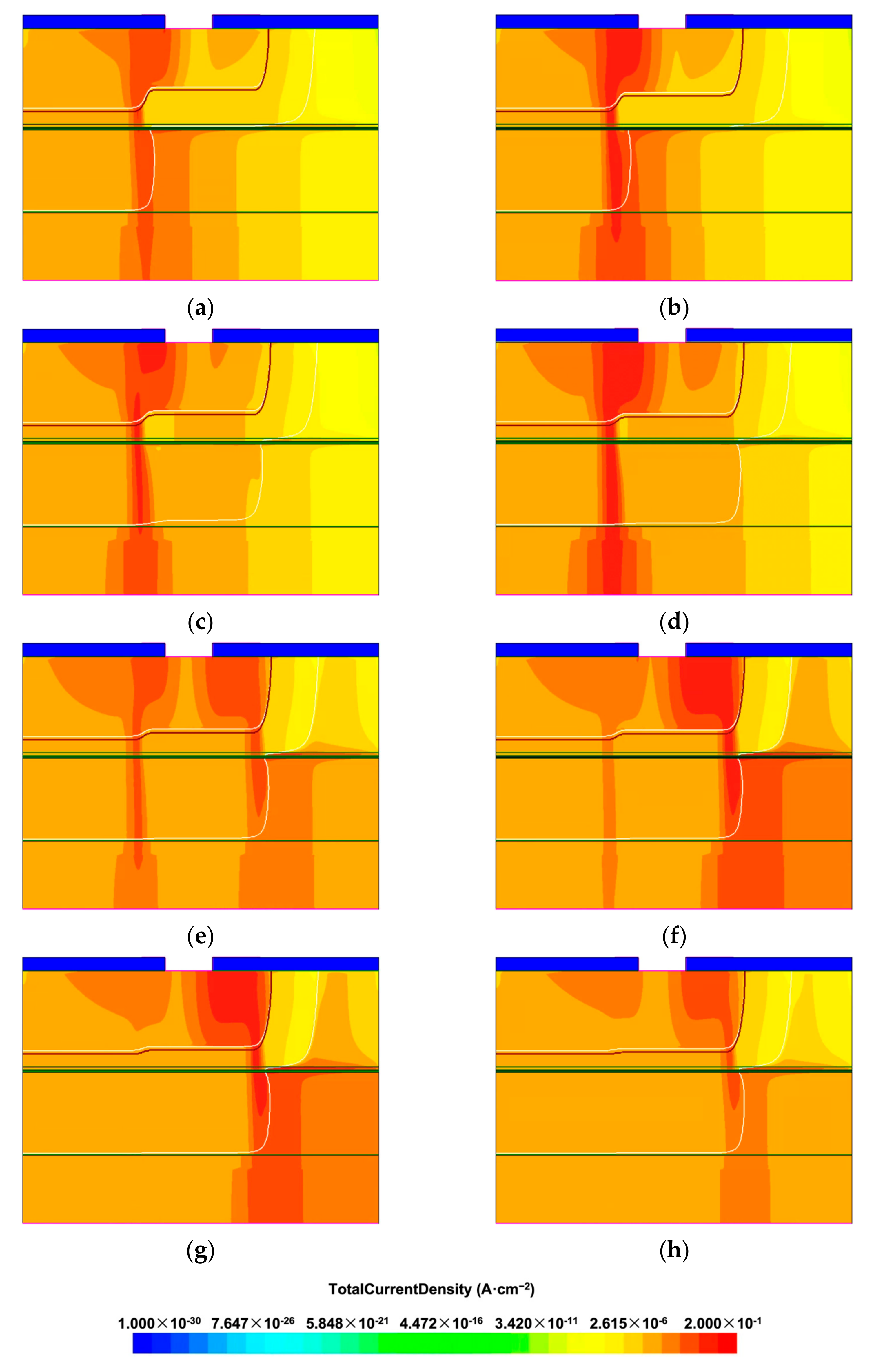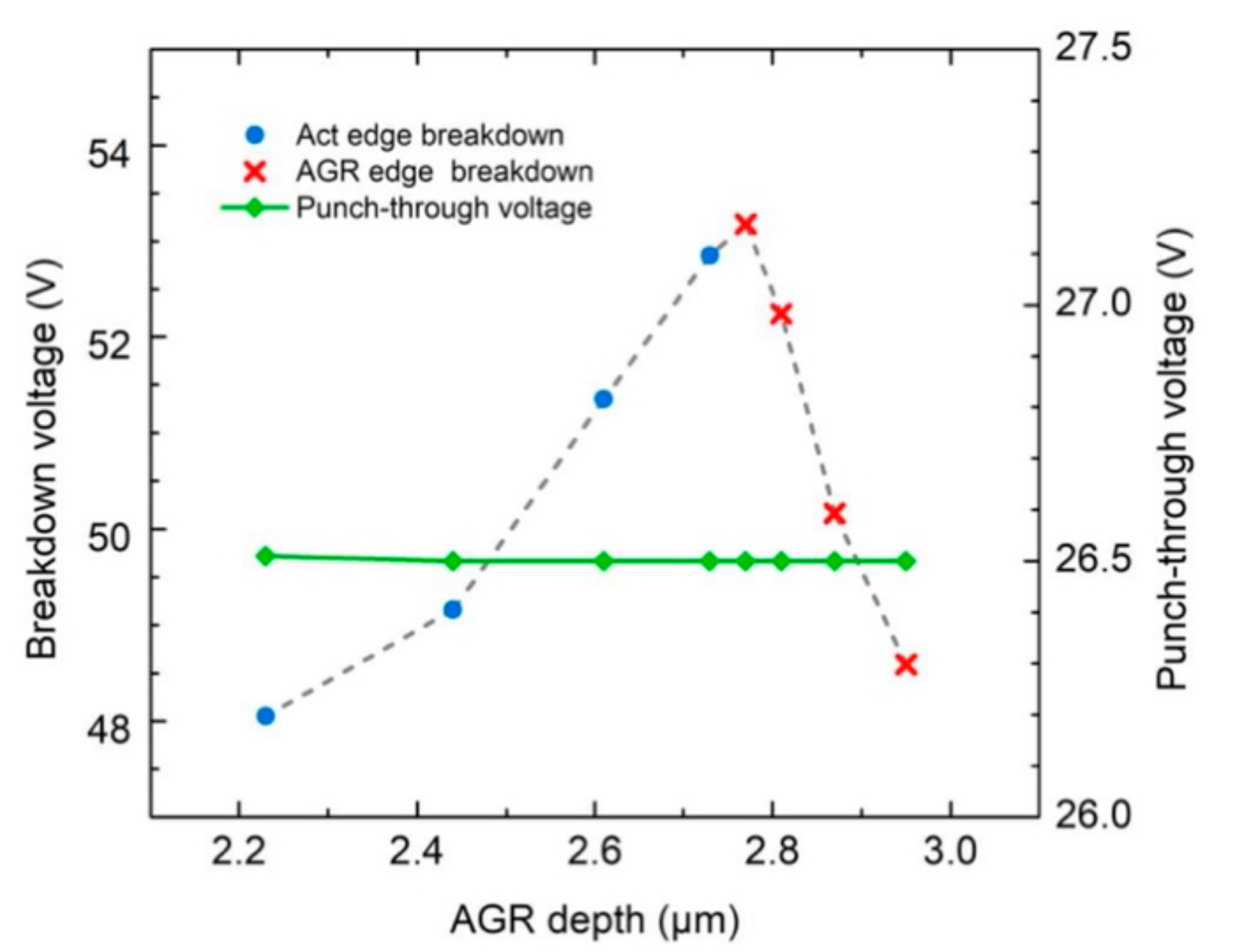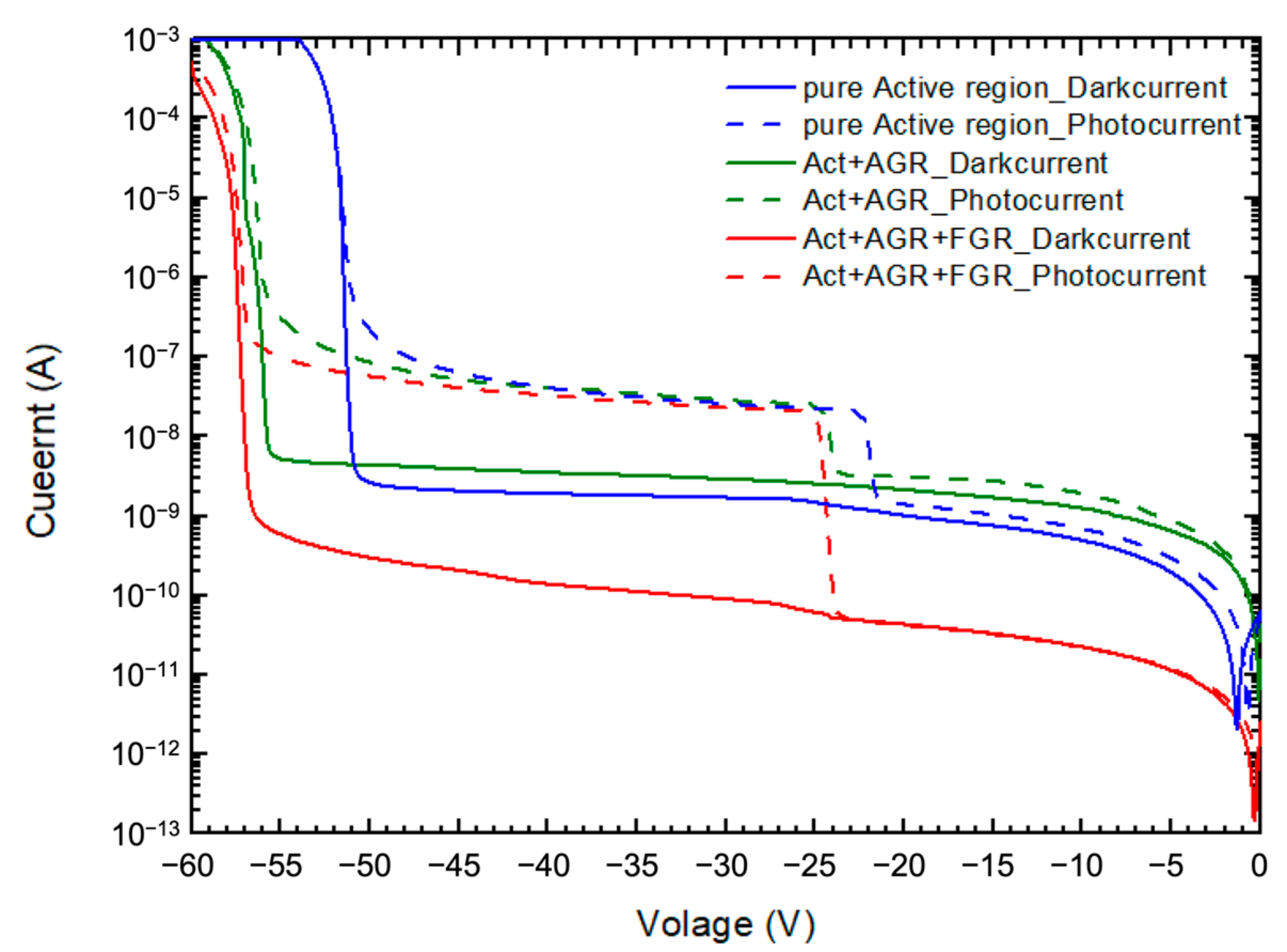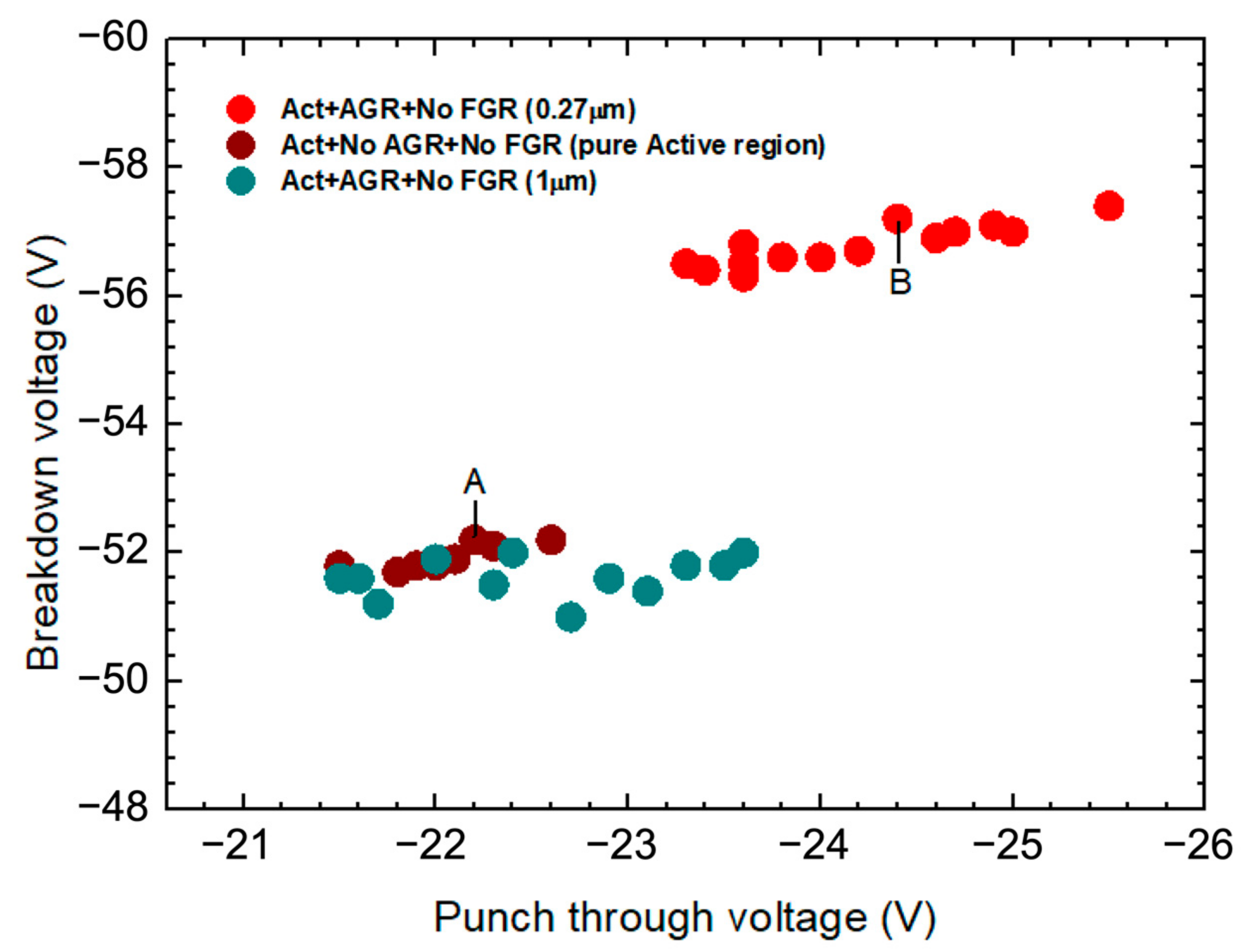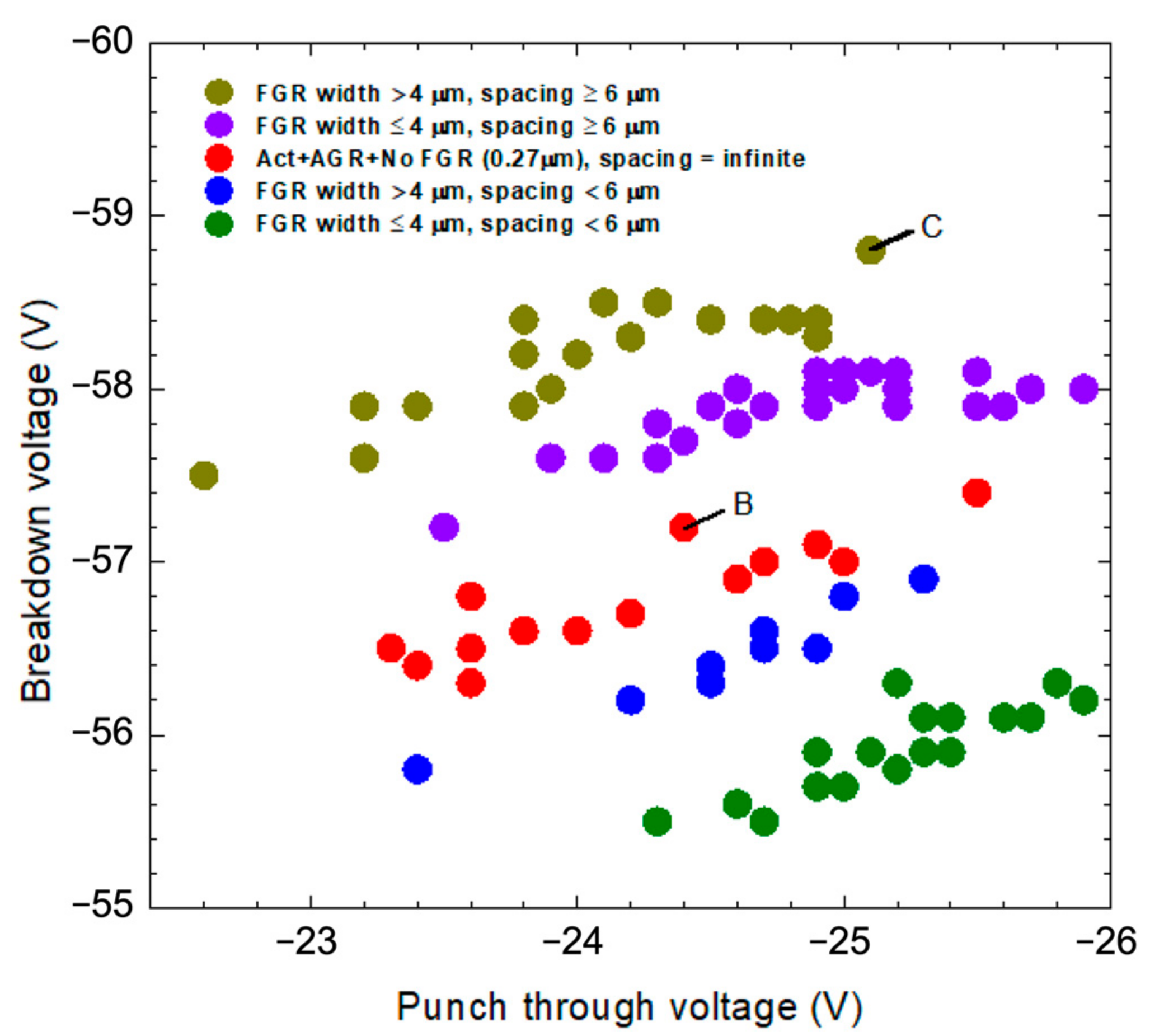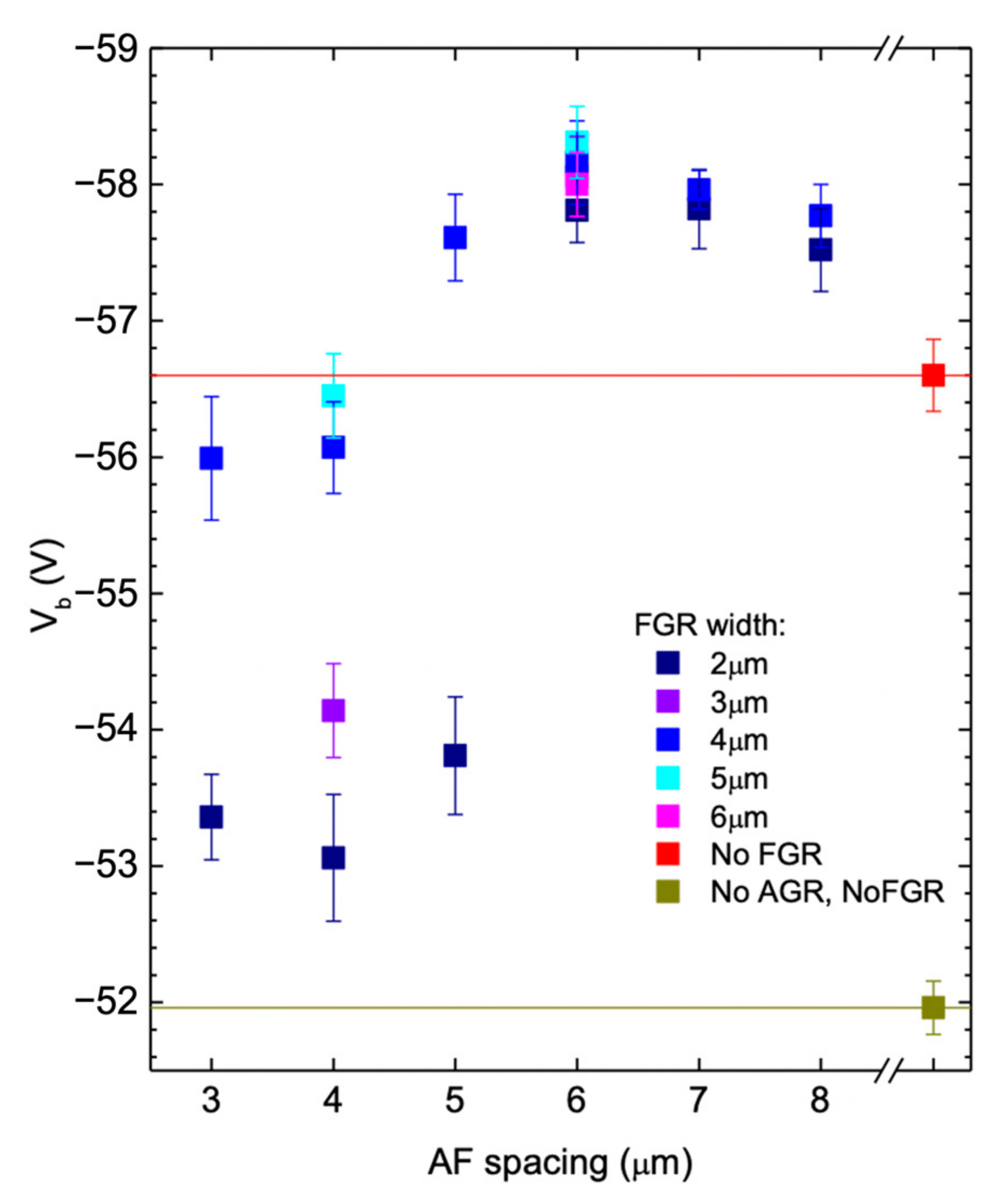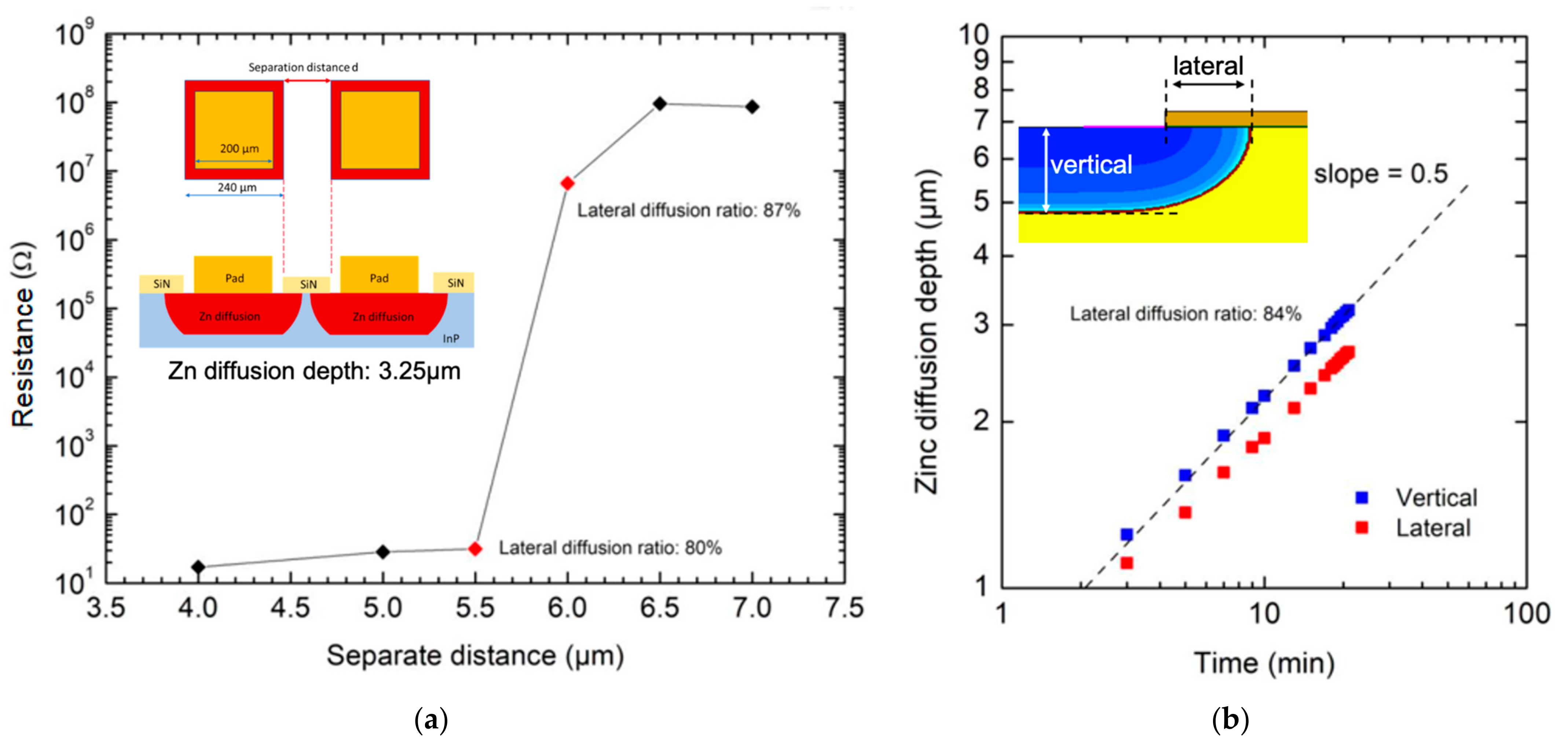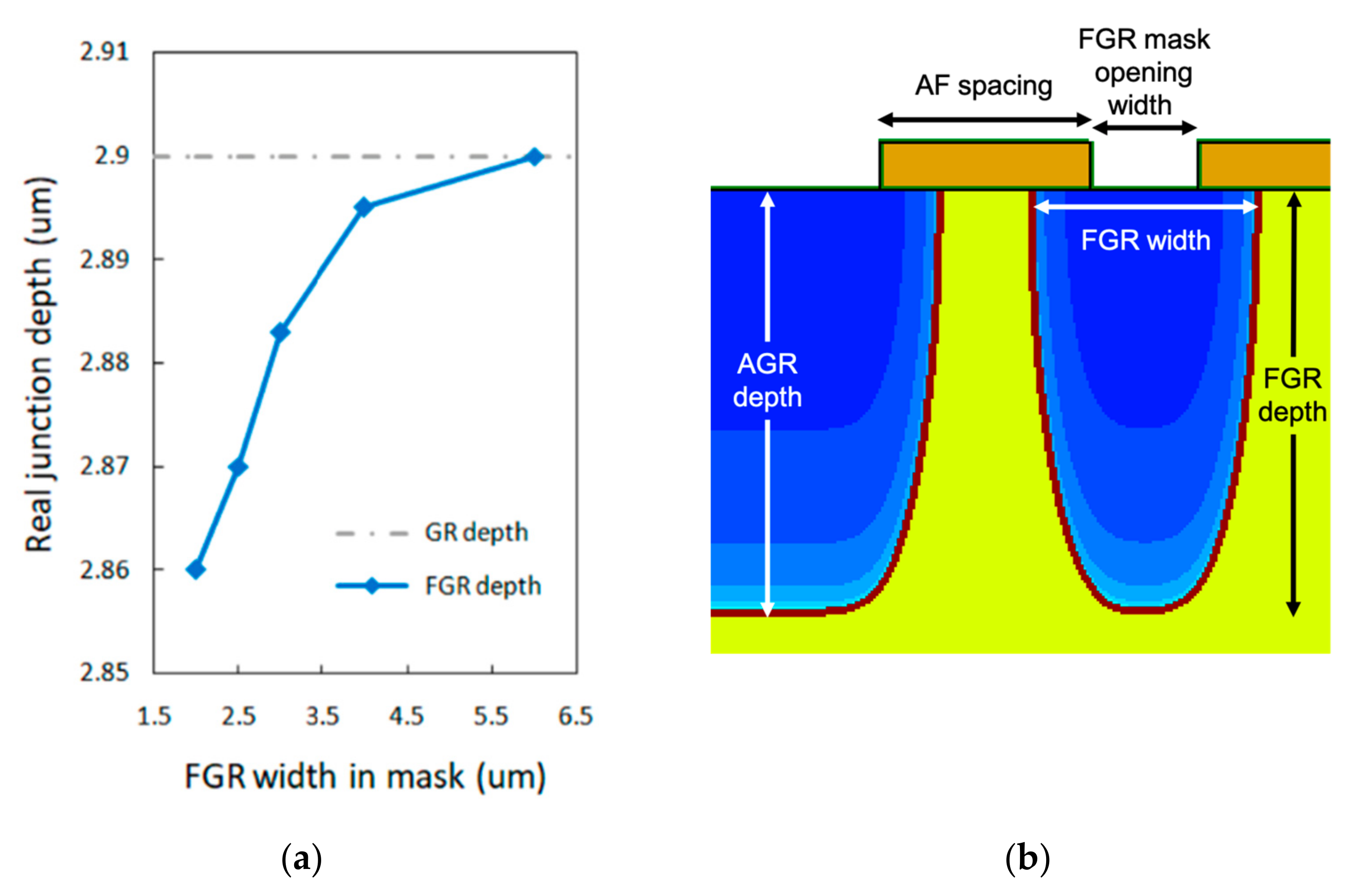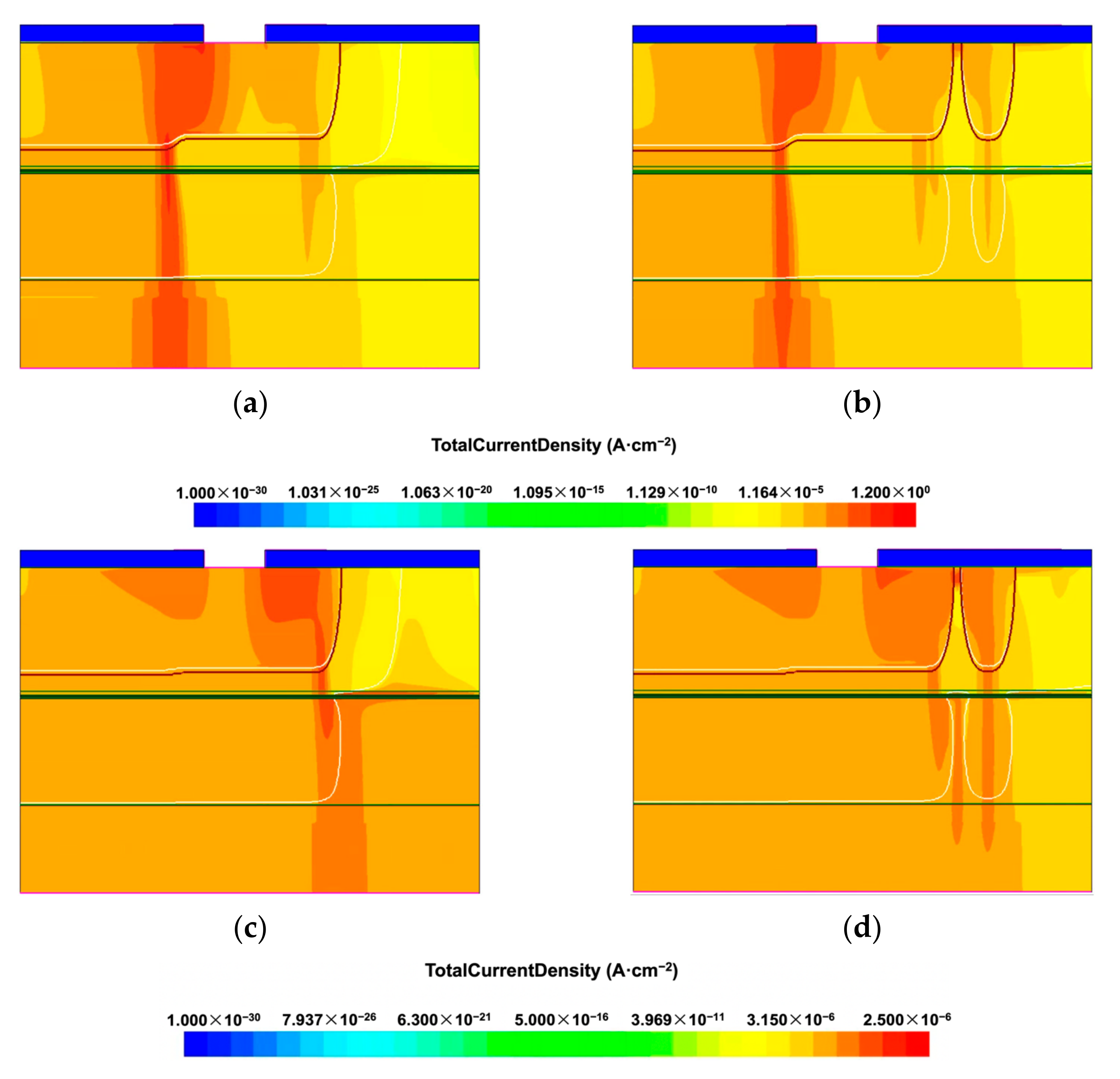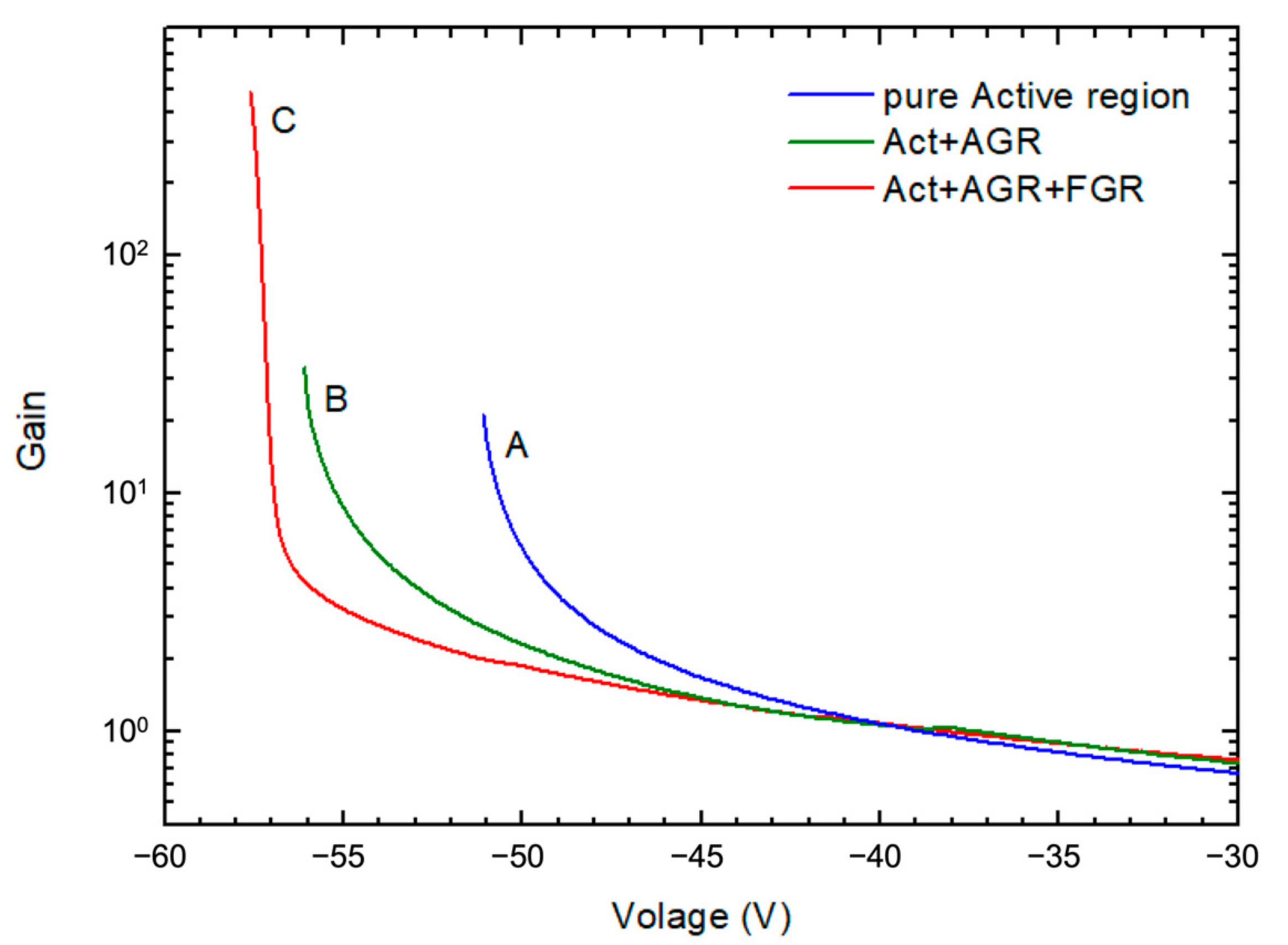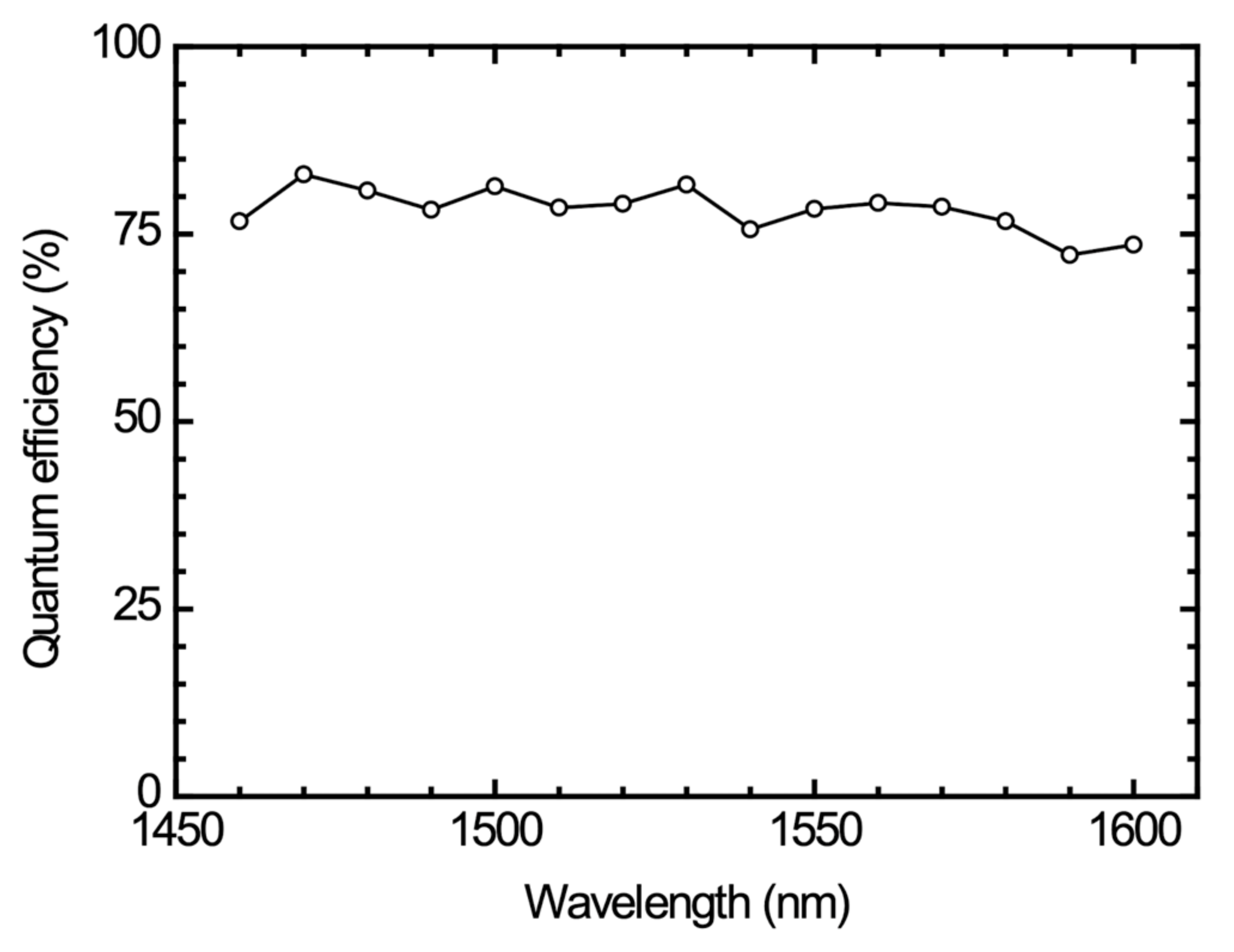In this work, we investigate the designs of AGR diffusion depth, the spacing between the AGR ring and FGR ring, and the ring width of FGR in a simple dual diffused SAGCM InGaAs/InP APD device. The epilayer structure is shown in
Figure 1a. For the smallest APD device, the radius of the active region is 50 µm, and the width of the AGR ring is 25 µm. In the TCAD simulation, the active region’s radius is shortened to 25 µm to save the run time. The 25 µm radius was selected after a study on the dependence of breakdown behavior on the active region radius. When the radius is equal to or larger than this value, the breakdown voltage becomes radius independent, indicating that the radius is large enough to consider the edge effect. The rest of the structure, i.e., the AGR and FGR, are kept the same as those of the actual devices.
4.1. Diffusion Depth of Attached Guard Rings
Figure 2 shows the dark current distribution at the breakdown voltage of APD devices with different AGR diffusion depths, simulated by TCAD. The diffusion depth in the active region is 3.04 µm. As shown in
Figure 2a–d, for cases of AGR depth from 2.23 µm to 2.73 µm, the current clearly concentrates around the active region’s edge. However, the figures also reveal a current gradually developing in the AGR region with increasing AGR depth. In
Figure 2e,f, for the cases of AGR depth = 2.77 µm and 2.81 µm, we can see that the devices show two breakdown current paths located at the edge of the central active region and the edge of the AGR region, respectively. Comparing the current distribution in these two figures, we can find that the current gradually shifts from the edge of the active region to the AGR edge when the AGR depth increases. As can be seen in
Figure 2g,h, for the cases with deeper AGR depth, the current path at the edge of the central region ceases, and the breakdown occurs at the AGR edge.
Figure 3 shows the breakdown voltage extracted from the simulations shown in
Figure 2a–h. The blue dots represent the cases in
Figure 2a–d, where the breakdown still occurs at the edge of the central region. In these cases, the breakdown voltage increases with the increasing AGR depth. On the other hand, the red Xs represent the cases in
Figure 2e–h, in which the breakdown path at the AGR edge gradually take over the breakdown current. In these four cases, the breakdown voltage decreases with the increasing AGR depth. From
Figure 3, it can be seen that the most significant breakdown voltage is located at the boundary of the two regions, i.e., a device with an AGR depth of 2.77 µm. In this case, the two edges reach the breakdown condition nearly simultaneously, indicating that the electric field resulting from the bias voltage is properly distributed in these two edges to achieve the best breakdown behavior. The difference between the diffusion depth in the central and AGR regions is only 0.27 µm. We attribute this slight difference to the steep diffusion front end of the concentration-dependent Zn diffusion [
17]. The steep front end causes the edge breakdown to take place at the bottom corner, as shown in
Figure 2, and limits the influence of AGR on the junction profile of the bottom corner until the AGR front is very close to the corner. The punch-through voltage of these devices is also shown in
Figure 3. Since the multiplication layer thickness under the central active region is fixed, the punch-through voltage is independent of the AGR depth.
The optimal structure, obtained from
Figure 2 and
Figure 3, was used to design the diffusion times for the two Zn diffusions performed on our APD devices. Dual diffusions form the active region, with an accumulated depth of 3.04 µm. While the AGR and FGR are created only by the second diffusion, and the depth is 2.77 µm. The dual diffusion also generates a 0.46-µm-thick multiplication layer in the active region. In practice, we arranged test devices to monitor the diffusion depths by measuring their punch-through voltage. However, the punch-through voltage of the finished APD devices in this batch varied from −21.5 V to −25 V. The corresponding variation of dual-diffusion depth is from 3.09 µm to 2.99 µm.
Figure 4 shows the typical dark and photo I-V characteristics of our three APD devices fabricated in the same batch, but with different guard ring designs. Red curves represent the I-V behavior of the device with AGR and FGR structure. The diameter of the active region is 100 µm, and the opening widths for AGR and FGR are 25 µm and 4 µm, respectively. The spacing between AGR and FGR is 6 µm. Green and blue curves represent the I-V behaviors of the device with AGR, but without FGR, and the device without any guard rings, respectively. The AGR opening width and active region radius are the same as those of the device with AGR and FGR. As can be seen, all the devices have their dark current at 0.9V
b in the level of 10
−9~10
−10 A. In addition, the two devices with AGR have larger breakdown voltages than the one without AGR, indicating the advantage of using an AGR structure. The breakdown voltage of the device with AGR and FGR is slightly higher than that of the device with AGR only, suggesting that the effect of FGR is minor. In this work, the breakdown voltage, V
b, is defined as the bias voltage when the dark current reaches 100 µA.
Figure 5 shows the breakdown voltage as a function of punch-through voltage for three groups of APD devices. Red and brown circles represent the groups of devices with and without AGR, respectively. These two groups of devices were fabricated in the same batch with the aforementioned optimal diffusion conditions. As can be seen, the breakdown voltage slightly increases with the increasing punch-through voltage, which is the expected behavior of APD devices. In our structure, devices with thinner multiplication layers have lower punch-through voltage and breakdown voltage. The slight variation in punch-through voltage is relevant to the uniformity of the epi-growth and Zn diffusion. Comparing the trends of red and brown circles, the breakdown voltages of the devices with AGR are ~5 V higher than those without AGR. Another group of devices, represented by dark green circles, was fabricated in another batch, with different diffusion parameters. Their AGR depth is 2 µm. The breakdown voltages of this group of devices, as shown in
Figure 5, are very close to those of devices without AGR in the batch with optimal diffusion conditions. Since the 2 µm AGR depth is far above the bottom corner of the active region, this finding confirms our argument that AGR does not affect the breakdown behavior until its depth is very close to the bottom edge of the active region.
4.2. Design of Floating Guard Rings
Based on the optimal AGR structure, we turn to the FGR structure. In the design of FGR, two parameters, the spacing between the opening widows of AGR and FGR in photomasks for Zn diffusion, hereafter called AF spacing, and the width of the FGR’s opening window, are tuned to study how these two design parameters affect the breakdown voltage. In this study, we designed different FGR widths, varying from 2 to 6 µm, and six different AF spacings, ranging from 3 µm to 8 µm. In addition, the devices without FGR are also included in the comparative study.
Figure 6 shows the breakdown voltage of the APD device with different FGR designs as a function of punch-through voltage. The results are divided into five groups, according to their breakdown behaviors. The olive-green dot represents the group with an FGR width > 4 µm and an AF spacing ≥ 6 µm, with the highest breakdown voltage. The group of devices with an FGR width ≤ 4 µm and an AF spacing ≥ 6 µm, represented by purple dots, has the second-highest breakdown voltage. Thus, we can see the group of devices without FGR, represented by red dots, lies below those represented by purple dots. The other two groups of devices with an AF spacing < 6µm have smaller breakdown voltage than those without AGR. In these two groups, the example with an FGR width > 4 µm has a higher breakdown voltage than the other.
The findings from
Figure 6 suggest that AF spacing has a critical value of 6 µm. When the spacing is above the critical values, the devices show better breakdown behaviors than the devices without FGR. On the other hand, when the spacing is below the critical value, the breakdown voltages are worse than those of the devices without FGR. Whether the AF spacing is above or below the critical value, a larger FGR width results in higher breakdown voltages. However, the effect of the FGR width seems less significant than that of AF spacing.
To further understand the relationship between the breakdown voltage and the FGR design,
Figure 7 shows the breakdown voltage as a function of AF spacing. For each AF spacing, results with different FGR widths are shown with error bars. The red horizontal line, representing the average breakdown values of devices without FGR, separates the result into two categories. For AF spacing less than 4 µm, all devices have breakdown voltages below the red line, the breakdown voltage of devices without FGR. When the AF spacing is 5 µm, the devices are divided into two groups, one above the red line and the other below the red line. The group shows better breakdown voltage with a wider FGR width of 4 µm, suggesting that a wider FGR width provides better breakdown voltage. A similar trend can also be observed in other groups. When AF spacing goes over 6 µm, regardless of FGR width, all devices have exhibit better breakdown voltages than the devices without FGR. However, the average breakdown voltage still increases slightly with the widening of the FGR width. From this figure, one can determine a critical value for AF spacing, which is 6 µm. From the figure, we also found that the effect of AF spacing on the breakdown behavior seems to be more prominent than that of FGR width.
Notice that the aforementioned FGR width and AF spacing are the nominal distances on the photomasks. However, thermal diffusion is a random walk process of Zn atoms, and lateral diffusion beneath the SiN mask is inevitable. The lateral diffusion shortens the distance between AGR and FGR and, and, even worse, it may short-circuit the AGR and FGR and fail to function in the FGR.
To evaluate the lateral diffusion length in our diffusion condition, we designed a test kit consisting of pairs of square openings with different spacings for Zn diffusion. After the diffusion, metal contacts were deposited on the openings for I-V characterization.
Figure 8a shows the resistance as a function of spacing. A schematic diagram of a test pair is shown in the inset of this figure. As can be seen, the resistance possesses a distinct transition from ~20 Ω to 10
7~10
8 Ω, when the separation distance is between 5.5 and 6 µm. The growth suggests a lateral length of 2.7~3 µm. The vertical diffusion depth is determined from the devices’ punch-through voltage, and it is 3.25 µm. The experiment indicates that the lateral length is ~0.87 of the diffusion depth.
Figure 8b shows the results from TCAD simulation of vertical diffusion depths and lateral diffusion length as functions of diffusion time. The Fermi model was used for the simulations. Both vertical diffusion depth and lateral diffusion length are proportional to the square root of the diffusion time. Their results, represented by blue and red squares, are in parallel in the log–log plot, suggesting that the lateral diffusion length is ~0.84 of the vertical diffusion depth, which is close to the ratio obtained from the experimental test.
Since the diffusion depth of the AGR is ~2.8 µm, the estimated lateral diffusion length is ~2.5 μm. Therefore, the AF spacing will be reduced by ~5 µm by the lateral diffusions from the inner and outer sides. For the AF spacing of 2 µm to 4 µm, the FGR may connect to the AGR directly, losing its utility. When the AF spacing is 6 µm or larger, the FGR and AGR are effectively separated to allow the depletion region of FGR to affect the edge of AGR, without the physical contact of AGR and FGR. As shown in
Figure 6, the two groups of devices with AF spacing ≥ 6 µm have a higher breakdown voltage than those without FGR, and the same result can also be seen in
Figure 7.
We also found that when the size of the diffusion opening is close to the lateral diffusion length or vertical diffusion depth, the limit of the Zn source may affect the diffusion depth. We performed TCAD simulations to study this issue.
Figure 9a shows the calculated vertical diffusion depth as a function of the opening width of FGR. All data points were created using the same diffusion time.
Figure 9b shows a cross-section of the AGR and FGR structures, in which the lengths and positions of actual FGR width, FGR mask width, and FGR depth after diffusion are indicated. In this simulation, the much wider diffusion opening results in an AGR depth of 2.9 µm. In contrast, the vertical diffusion depth of the FGR decreases when the FGR width decreases from 6 µm to 2 µm. This opening size effect can explain the finding obtained in
Figure 7, in which the breakdown voltage increases with the increasing FGR width. In
Section 4.1, we have shown that the breakdown occurs around the bottom corner of the AGR region. For the FGR with a wider opening width, the diffusion depth is closer to that corner, allowing the FGR to reduce the electric field around the corner and thus improve the breakdown behavior, even though the improvement is minor.
TCAD simulation was also performed to understand the effect of FGR on the current density distribution at the breakdown voltage of the devices.
Figure 10a,b shows the current density distribution in the devices, without and with FGR, respectively. The diffusion depth of their AGR is 2.73 µm, and the AF spacing is 6 µm. For the device without FGR, the breakdown current concentrates at the edge of the active region, as seen in
Figure 10a. When the FGR is used, the current at the active region’s edge decreases, and the currents in AGR and FGR increase, as shown in
Figure 10b. The use of FGR increases the breakdown voltage from −52.85 V to −52.96 V.
Figure 10c,d also shows the current density distribution in devices, without and with FGR, respectively. The diffusion depth of the AGR is 2.95 µm, and the AF spacing is 6 µm. In
Figure 10c, the breakdown current concentrates at the edge of the AGR. The use of FGR significantly decreases the current at the AGR edge and increases the breakdown voltage from −48.59 V to −48.68 V.
The simulation indeed shows that the use of FGR improves the breakdown behavior. However, the amount of improvement in the breakdown voltage is much lower than that of the experimental results we observed in
Figure 7. We attribute the discrepancy largely to the fabrication process of the experimental devices. Basically, the TCAD model can fit the vertical diffusion depth quite well. However, the protection of FGR is obtained through the lateral depletion region. Because the lateral diffusion is strongly dependent on the surface vacancy density, which could be drastically affected by the preparation of the SiN diffusion mask, and other processing steps, we believe that the experimental devices could have a softer lateral diffusion front, and thus show better improvement.
